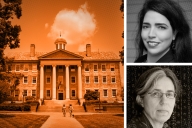You have /5 articles left.
Sign up for a free account or log in.
During this summer's governance turmoil at the University of Virginia, faculty leaders pushed for formal representation on the institution's board, arguing that the lack of a faculty voice on the board may have contributed to the disconnect between trustees and the rest of the university.
A new survey of faculty trustees has found that they believe that they do have an influence on governance. But the survey found that key differences between the way colleges treat faculty trustees and other trustees limit their influence. Specifically, most faculty trustees serve for shorter terms than do other trustees. And they tend to be assigned to certain committees (such as academic affairs) over others (such as executive committees), and rarely chair board panels.
The survey was conducted by the Cornell University Higher Education Research Institute, whose director, Ronald G. Ehrenberg, has served as a faculty-elected trustee on the Cornell board and who is currently a gubernatorial appointee to the board of the State University of New York.
Cornell and SUNY are, however, in the minority of colleges and universities in having spots for faculty members on the board. According to the Association of Governing Boards of Universities and Colleges, 15 percent of private institutions and 13 percent of public institutions have faculty trustees with voting power. Another 14 percent of private institutions and 10 percent of public institutions have non-voting faculty trustees. AGB recommends against having faculty members serve on boards, saying that such service constitutes a conflict of interest.
To judge from the new report, the influence of faculty trustees is real, but limited to certain areas. By far, the area where the 108 faculty trustees were most likely to report influence was academic affairs. Relatively few reported influence on matters of presidential appointments or removals.
Areas of Faculty Trustee Influence
| Area | % Reporting Influence |
| Academic Affairs | 49% |
| Finances/budget | 31% |
| Faculty compensation | 21% |
| Student life | 15% |
| Presidential evaluation | 10% |
| Presidential search | 8% |
| Presidential removal | 5% |
One caveat in the above list is that faculty trustees from campuses with a separate finance and budget committee were much less likely to report that they had influence in that area.
The areas of influence correspond with the committee assignments faculty trustees receive. Almost all (98 percent) reported serving on academic affairs committees, with student life (at 82 percent) also being a common appointment. But only 26 percent of the faculty trustees served on executive committees, which frequently act for the board between full board meetings. Executive committee membership is an area where the report found a significant difference between the experience of faculty trustees at private institutions (where 31 percent had served) and publics (where only 12 percent had served).
Many faculty trustees reported that their influence was limited by their relatively short tenures on boards. The average term of appointment for those in the survey was 2.35 years. AGB data indicate that the average term for public board members is six years and for private board members is three or four years. The report notes that the impact of short board tenures could be mitigated by faculty trustees being reappointed. But in some cases this is impossible either because people serve on boards by virtue of their positions in faculty governance bodies (and those roles have term limits) or because faculty selection systems require rotation of appointees.
The authors of the report on the survey are Ehrenberg, director of the Cornell higher education center; Richard Patterson, a Ph.D. student in policy analysis at Cornell; and Andrew Key, an undergraduate at the university.








